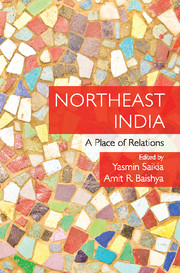Book contents
- Frontmatter
- Contents
- List of Figures
- List of Boxes
- List of Tables
- Acknowledgments
- Introduction
- Section I Contemporary Politics and Issues of Definition
- Section II Creating Presence
- Section III Knowing through Experience
- Section IV Rethinking Politics
- 10 Difficult Loves: Purity and Hardship
- 11 Politics of Difference in the Northeast: A Feminist Reflection
- 12 Robes, Rivers and Ruptured Spaces: Hydropower Projects in West Arunachal Pradesh
- Glossary
- About the Contributors
- Index
12 - Robes, Rivers and Ruptured Spaces: Hydropower Projects in West Arunachal Pradesh
from Section IV - Rethinking Politics
Published online by Cambridge University Press: 23 July 2017
- Frontmatter
- Contents
- List of Figures
- List of Boxes
- List of Tables
- Acknowledgments
- Introduction
- Section I Contemporary Politics and Issues of Definition
- Section II Creating Presence
- Section III Knowing through Experience
- Section IV Rethinking Politics
- 10 Difficult Loves: Purity and Hardship
- 11 Politics of Difference in the Northeast: A Feminist Reflection
- 12 Robes, Rivers and Ruptured Spaces: Hydropower Projects in West Arunachal Pradesh
- Glossary
- About the Contributors
- Index
Summary
Protests erupted in Tawang towards the end of 2011. Tawang is a small Buddhist preserve in the far-flung borders of Northeast India, wedged between Bhutan and Tibet; with its centuries-old monasteries, stupas, red-robed monks and narrow market lanes selling Tibetan wares and crafts, it has a placid, other-worldly charm. Between 2011 and 2012, however, early mornings in the sleepy market places were disrupted by agitating monks shouting slogans against the proposed mega hydropower dams in the region.
In May 2013, when I visited Tawang on a field work trip, the protests had abated somewhat, although the tension simmered through in conversations that I snatched with both the laity and clergy of the town. On one side of the divide were those who favoured the building of dams; the district administration and state government, young professionals and government officials, who spoke the language of development and modernization. On the other side were the protestors, consisting of a section of monks, student groups and rural youth mobilized through the campaign. I wanted to interview the leader of the antidam movement in Tawang, a monk from Tawang Monastery, but as he was out of town, I spoke to other monks, who were also divided in their opinion about the dams. One of them dismissively stated that the protests were all instigated from elsewhere, and that the leader too was acting at the behest of his advisers based in Tibetan settlements in South India.
The debates around dams in Tawang show how global connections (Tsing, 2005) influence local ideas of place. According to anthropologist Anna Tsing, global connections or the encounter between global ideologies and particular local contexts are everywhere specific and hence, it is important to study ethnographically global encounters across difference. In Tawang, global encounters are seen in the contestations around hydro-power projects; pro-dam proponents are driven by a neo-liberal discourse of corporate development while the monk-protestors espouse an environmentalist discourse promoted by the Tibetan exile community in dialogue with international environmentalists. These opposed objectives, in turn, shape and are shaped by different spatial imaginations of Tawang.
- Type
- Chapter
- Information
- Northeast IndiaA Place of Relations, pp. 262 - 276Publisher: Cambridge University PressPrint publication year: 2017
- 5
- Cited by

